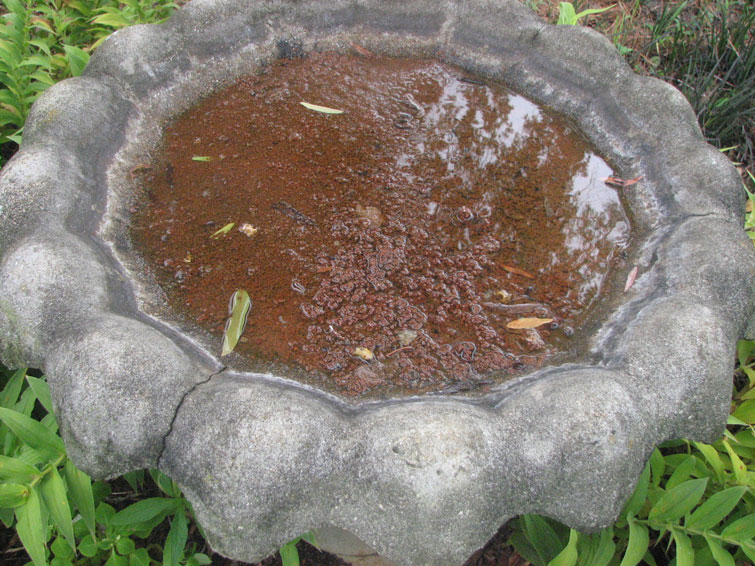If you have a birdbath in your yard, you probably are familiar with the effects of prolonged sunlight and exposure to birds on a birdbath: feathers and waste, algae, shells and other pond scum can build up very quickly to create a rather hazardous situation. The key is to stay on top of cleaning to create an environment that is welcoming and inviting to our fine, feathered friends.

Photo courtesy of Dave Anderson
To help our readers who may be new to owning birdbaths and what they require for maintenance, we have a step-by-step breakdown of the cleaning process to help boost your confidence. Cleaning a birdbath is a snap with the right equipment and know-how.
What you’ll need:
- Rubber gloves
- A stiff bristled brush
- White vinegar or a highly-diluted bleach solution and a black plastic bag (for deep cleaning with less scrubbing)
- A bucket
- A water source (bonus points for a high-pressure hose attachment!)
Birdbath Cleaning Instructions:
- Get rid of the contaminated water by tipping your bath into an unused portion of your garden or yard. Scoop out any organic material while wearing gloves. You can even use this water to fertilize your garden, if you choose. Avoid dumping near bird feeders.
- Using pressurized water or a bucket and scrub brush, scour the surface diligently and carefully.
- Refill the birdbath until it is almost full and at or above its previous level.
- Depending on how dirty your birdbath is, you can vary your cleaning method. Keep in mind that bleaches and commercial products may contain elements or chemicals that may be harmful to wildlife if consumed.
- For regular, twice weekly cleaning:
- Use about 1 tablespoon per gallon of white or apple cider vinegar and water. The vinegar is natural, and so regular use won’t harm the birds.
- Scrub your bath with the solution for five minutes or so.
- Drain water in an unused part of your yard.
- Rinse the bath with pressurized water, if possible.
- For a deep clean:
- Use 1/2 cup of bleach and cover the birdbath with the black plastic bag, allowing it to sit in the sun for 20 minutes or so. Trapped heat between the bag and water will help break down algae that won’t come off otherwise.
- Drain the water far away from your garden and birdbath, and rinse very thoroughlyyou don’t want to irritate the birds, and they are very sensitive to chemicals.
- Finish with a scrub brush and an additional rinse with pressurized water if possible.
- Reuse the bag if you plan on deep-cleaning more often than once a month.
- Allow the birdbath to completely dry in the sun. This helps to further sterilize the basin, while discouraging algae from forming a foundation. You can skip this step if necessary.
- Refill your birdbath with cool, clean water for the birds to enjoy. 1-2 inches is sufficient for them to drink and bathe. Consider adding stones, drippers, or a mister to keep water circulating and the birds playful.
PRO TIP: Putting your birdbath in the shade and adding copper can help discourage algae growth! In the United States, any penny made before 1982 is mostly copper. Copper tubing is available at local hardware stores as well.



